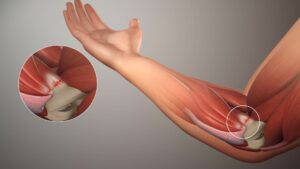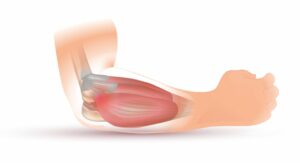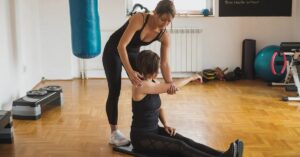Do you experience pain and discomfort in your elbow? You may have medial epicondylitis, otherwise known as golfer’s elbow. This condition is caused by overuse of the muscles and tendons that attach to the medial epicondyle, a bony protrusion on the inside of your elbow. Physical therapy can help to relieve the pain and improve function. In this blog post, we will discuss how physical therapy can help in medial epicondylitis and some of the exercises that you can do at home to improve your symptoms.
Contents
What is Medial Epicondylitis?
 Medial epicondylitis, commonly known as golfer’s elbow, is a painful condition affecting the tendons of the forearm near the elbow. It usually occurs when the flexor muscles in the forearm become overused from repeated motions or heavy lifting. Many people who play golf and racket sports, as well as manual laborers, are especially prone to golfer’s elbow.
Medial epicondylitis, commonly known as golfer’s elbow, is a painful condition affecting the tendons of the forearm near the elbow. It usually occurs when the flexor muscles in the forearm become overused from repeated motions or heavy lifting. Many people who play golf and racket sports, as well as manual laborers, are especially prone to golfer’s elbow.
The main symptom of medial epicondylitis is pain in the inner side of the elbow that radiates into the muscles of the forearm. Other symptoms include:
- Tenderness
- Stiffness
- Burning sensation
- Weakness in the forearm
These are just a few of the most common symptoms of medial epicondylitis. The causes of golfer’s elbow are varied, but they include overuse of the flexor muscles in the forearm and repetitive motions such as swinging a golf club or lifting heavy objects.
How Physical Therapy Helps with Medial Epicondylitis?
Physical therapy is an effective way to reduce pain and improve function for medial epicondylitis sufferers. It uses different techniques to treat inflammation, strengthen muscles and tendons, reduce stress on affected tissues, and improve overall fitness.
Here are a few different techniques of physical therapy that are used to treat medial epicondylitis. These include:
Pain Management
One of the most common things that they use is pain management, which helps to reduce pain and discomfort in the area. In this, the physical therapist helps you to avoid activities that may aggravate the injury and use different methods such as:
- Ice
- Heat
- Electrical stimulation
- Bracing and splinting
It is important to manage the pain that the condition is causing you because after that only other physical therapy techniques can be used.
Strengthening Exercises
Physical therapists also teach strengthening exercises to help strengthen the muscles and tendons of the elbow and forearm. Strengthening exercises should focus on building the muscles around the medial epicondyle and the wrist flexors, as well as improving the range of motion of the elbow. Some exercises that may be used include:
- Wrist curls: This exercise is done by gripping a lightweight (such as a dumbbell) in the hand and then curling the wrist up and down. The patient should do 10-15 repetitions of this exercise, with a few sets.
- Elbow flexion: This exercise is done by sitting in a chair, holding a lightweight in the hand, and then bending the elbow up and down. This exercise should also be done 10-15 times, with a few sets.
- Forearm pronation and supination: This exercise is done by sitting in a chair and then rotating the forearm from palm up to palm-down, down, and then back again. Again, this should be done with 10-15 repetitions with a few sets.
These exercises should be done daily in order to strengthen the muscles and tendons of the elbow and forearm. If these exercises are too difficult or painful, they can be modified by using only one arm at a time or by using a lighter weight.
Manual Therapy
 It is one of the most common treatments for medial epicondylitis. A physical therapist will use different hands-on techniques to help reduce pain and inflammation associated with a golfer’s elbow. This could include:
It is one of the most common treatments for medial epicondylitis. A physical therapist will use different hands-on techniques to help reduce pain and inflammation associated with a golfer’s elbow. This could include:
- Massage
- Stretching
- Joint mobilization and manipulation
- Soft tissue mobilization
The goal is to reduce muscle tension and improve the range of motion, while also increasing the flexibility of inflamed and surrounding tissues. This can help reduce pain and improve mobility and strength in the affected area.
Patient Education
The best part of physical therapy in the treatment of medial epicondylitis is patient education. Educating patients about how to use proper techniques for their activities helps prevent future injury and reduces pain associated with a golfer’s elbow. They will often provide instruction on proper warm-up and stretching techniques, as well as advice on when to stop or take a break from activities that might be causing pain.
And, also suggest alternate activities or techniques that can help reduce stress on the elbow joint. So, an accurate understanding of the condition is an important part of the treatment.
Functional Training
Finally, physical therapist help with medical epicondylitis by implementing a functional training program. This type of program focuses on re-training the body’s movement pattern to help avoid the recurrence of symptoms or injury. The program includes movements that mimic everyday activities, such as throwing and tennis strokes so that the muscles around the elbow are trained for those specific motions.
So, these are some most common ways through which physical therapists help in medial epicondylitis. It is important to work with a qualified professional to diagnose and treat the condition properly for optimal recovery.
Furthermore, following an individualized exercise program helps maintain strength, flexibility, and range of motion—all of which are essential for a successful recovery from medial epicondylitis. With the right guidance and treatment, most cases of golfer’s elbow can be successfully managed with physical therapy.
What Are The Benefits Of Choosing Physical Therapy?
 There are many benefits to choosing physical therapy for treating medial epicondylitis (Golfer’s Elbow). Some of the common ones include:
There are many benefits to choosing physical therapy for treating medial epicondylitis (Golfer’s Elbow). Some of the common ones include:
- Pain relief: Physical therapy provides relief from the pain caused by medial epicondylitis through a combination of exercises. And manual techniques such as massage, joint mobilization, ultrasound, and electrical stimulation.
- Improved flexibility: A physical therapist can help to improve the range of motion in your elbow with specialized stretches. And movements that target the muscles and tendons around the joint.
- Strengthening: Exercises that target the specific muscles involved in medial epicondylitis can help to improve the strength, stability, and overall function of your elbow.
- Improved posture: Poor posture can lead to an increase in strain on the tissues of your elbow, which can worsen the symptoms of medial epicondylitis. Physical therapists can help to correct any postural faults and improve your posture.
- Prevention: A physical therapist can provide advice on how to use proper mechanics when performing activities that increase your risk of developing a Golfer’s Elbow, such as golfing or throwing a ball. The therapist can also provide advice on how to modify certain activities or sports to help reduce the strain placed on your elbow.
Overall, a physical therapist can provide an effective treatment plan tailored to your individual needs and goals. With their help, you can get back to doing the activities you enjoy without fear of worsening your condition.
What Are Some Exercises To Do At Home?
There are many exercises to do at home that can help relieve the pain of medial epicondylitis, also known as golfer’s elbow.
- Towel stretch
One exercise you can do is a towel stretch. To perform this exercise, you will need a towel and a wall or door handle. Start by placing your arm straight out in front of you. Wrap the towel around your hand and grab the end of it in your other hand. Pull on the towel with your free hand, keeping your elbow straight but bent slightly at the wrist. Hold this position for 30 seconds, then relax and repeat 3 times.
- Forearm pronation stretch
Another exercise to try is a forearm pronation stretch. Place your arm out in front of you and turn your palm up to the ceiling. Use your other hand to bend your wrist back slightly until you feel a stretch in the underside of your forearm. Hold this position for 30 seconds, then relax and repeat 3 times.
- Wrist flexion and extension
A third exercise is wrist flexion and extension with a resistance band. To perform this exercise, secure a resistance band around something sturdy like a doorknob. Hold the ends of the band in each hand and position your palms facing down. Keeping your elbow straight, pull the band towards you by bending at the wrist. Release and repeat 7-10 times. Then switch directions, keeping your elbow straight but turning your palms up to face you as you pull the band away from your body. Release and repeat 7-10 times.
These exercises are all easy to do at home. And can help you make progress toward relieving the pain associated with medial epicondylitis (Golfer’s Elbow). If you experience any sharp pain while doing these exercises, please stop immediately and consult with a professional.
Conclusion
In conclusion, medial epicondylitis can be effectively treated with physical therapy. Physical therapy exercises can help to increase strength and flexibility, reduce pain, and restore the normal range of motion in the elbow. In addition, physical therapists may use modalities such as ultrasound and electrical stimulation to relax muscles and reduce inflammation.
With consistent effort and dedication to a good physical therapy program, individuals can successfully manage their condition, prevent further injury and improve their overall quality of life.
Physical Therapy has always been proven to help patients recover from pain. Hence, if you’re experiencing Back pain, Shoulder pain, Knee pain, Neck pain, Elbow pain, Hip pain, or Arthritis pain, a physical therapist at MantraCare can help: Book a physiotherapy session.

